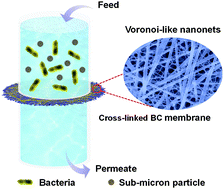An ultrathin bacterial cellulose membrane with a Voronoi-net structure for low pressure and high flux microfiltration†
Abstract
Developing a porous membrane to effectively remove sub-micron sized contaminants from water while maintaining a high permeate flux with energy-saving properties is of great significance but extremely challenging. Herein, we describe a feasible strategy to create a bacterial cellulose (BC) membrane with a continuous Voronoi-net structure via combining evaporation-induced self-assembly with chemical cross-linking. This presented approach allows micro-length BC nanofibers to self-assemble in the electrospun polyacrylonitrile (PAN) nanofibrous frameworks to form stable and continuous Voronoi-like nanonets, endowing the obtained membrane with small pore size, stable pore structure, high porosity, favourable interconnectivity, and ultrathin membrane thickness. By virtue of these unique structural advantages and superhydrophilicity from BC Voronoi-like nanonets, the resulting membrane exhibits integrated performances of high rejection efficiency (>99.63%) for 0.3 μm TiO2 microparticles, robust permeate flux (5541 L m−2 h−1) at a low driving pressure of 20 kPa, intriguing reusability, excellent bacterial rejection efficiency (log reduction value of 8.2), and promising antifouling function to bacteria. It is expected that the proposed strategy can provide a facile approach for the development of next-generation high performance microfiltration membranes.



 Please wait while we load your content...
Please wait while we load your content...